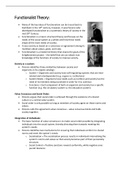Resume
Summary Theory - AQA Sociology A Level
- Cours
- Établissement
These notes cover all of Theory for AQA Sociology A Level including functionalism, feminism, Marxism, social action theories, modernity, postmodernity, objectivity and values, social policy, sociology and science.
[Montrer plus]



